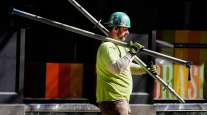US Added 313,000 Jobs in February; Wage Gains Cool to 2.6%

U.S. employers added the most workers since mid-2016 as labor-force participation swelled, while below-forecast wages and a downward revision to January’s figure suggest the pay gains that spooked markets last month haven’t yet taken hold.
Payrolls rose 313,000 in February, compared with the 205,000 median estimate in a survey of economists, and the two prior months were revised higher by 54,000, Labor Department figures showed March 7. The jobless rate held at 4.1%, the fifth straight month at that level. Average hourly earnings increased 2.6% from a year earlier following a downwardly revised 2.8% gain.
The report signals the labor market remains strong and will keep driving economic growth, while the wage figures show a cooling from a pace that spurred financial turbulence last month on concern that the Federal Reserve could raise interest rates faster. While the unemployment rate remains well below Fed estimates of levels sustainable in the long run, the rise in participation suggests the presence of slack that would keep policy makers to a gradual pace of hikes.
“This is a report that’s going to strengthen the argument of some of the doves on the Fed, that people came back to the labor force last month — that’s a positive sign for the U.S. economy,” Alan Krueger, a Princeton University professor who served as chairman of the Council of Economic Advisers under President Barack Obama, said on Bloomberg Television. “We’ll see how long that can continue.”
For now, rising labor-force participation may be a factor holding down wage gains. The participation rate increased to 63%, the highest since September, from 62.7% the prior month, the biggest monthly gain since 2010. The number of employed people in the workforce rose by 785,000, according to the report.
Powell’s Debut
Fed policy makers are widely anticipated to raise interest rates when they next meet March 20-21 in Jerome Powell’s first gathering as chairman. A bigger question is whether central bank officials maintain projections for a total of three quarter-point hikes this year, or boost the outlook to four.
Average hourly earnings rose 0.1% from the prior month following a 0.3% increase, the report showed. In the 12 months ended in February, analysts had forecast a monthly gain of 0.2% and an annual increase of 2.8%.
Employees worked more hours last month, which also may have played a role in the wage numbers. The average workweek for all private employees increased to 34.5 hours, from 34.4 hours. The initial data for January had shown a shorter workweek of 34.3 hours, which had the effect of boosting average hourly pay.
A separate gauge was more positive for wage growth. Average hourly earnings for just production and non-supervisory workers rose 2.5% from a year earlier, following a 2.4% gain in January.
Hiring was strong across the board and particularly in goods- producing industries. Construction businesses added 61,000 jobs, while factories boosted payrolls by 31,000. Service providers added 187,000 workers, including about 50,000 in retail, a sector that has been under pressure.
Growth in worker pay has been modest during most of this expansion, especially relative to how tight the job market is running. President Donald Trump has said the tax-cut legislation he signed in December will spur economic growth and boost jobs and wages. At the same time, his tariffs on steel and aluminum imports may become a headwind depending on how extensively they’re implemented and how other nations retaliate.
Other Details
• The U-6, or underemployment rate, was unchanged at 8.2%; measure includes part-time workers who’d prefer a full-time position and people who want a job but aren’t actively looking.
• People working part-time for economic reasons rose by 171,000 to 5.16 million.
• Private employment rose by 287,000 (median estimate 205,000) after increasing 238,000; government payrolls rose by 26,000.
With assistance by Chris Middleton, and Shelly Hagan


